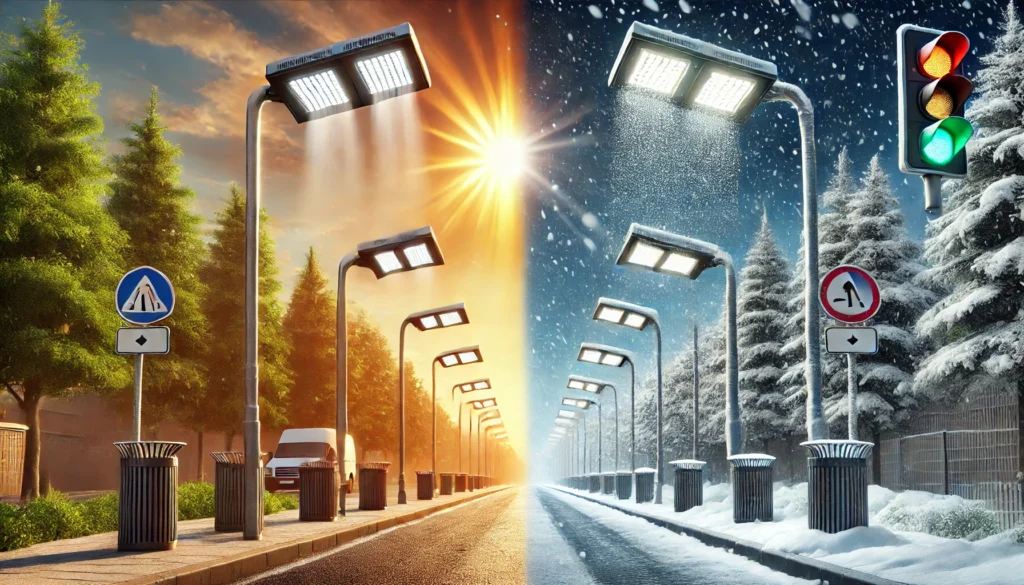Outdoor street lights serve as crucial components of urban infrastructure, ensuring public safety and security at all hours of the day. However, the performance of these lights is often subject to various weather conditions, which can impact their longevity and efficiency. This guide provides a comprehensive overview of the challenges posed by different weather conditions and the essential features and strategies necessary to ensure that street lights operate optimally throughout the year.
I. Understanding Weather Challenges
1. Extreme Temperature Variations
Outdoor street lights are exposed to extreme temperature fluctuations, which can place significant stress on their components. High temperatures can lead to overheating, while cold temperatures can cause issues with electrical components and delayed startups. Ensuring that street lights are built to handle such variations is crucial for their reliable operation in both summer and winter.

2. Precipitation Effects
Rain, snow, and ice can accumulate on street lights, potentially damaging components or reducing visibility. The ingress of moisture into electrical parts can lead to short-circuiting, corrosion, and decreased efficiency. As a result, street lights must be designed to handle various forms of precipitation without compromising their performance.
3. Wind Impact
Strong winds, especially in areas prone to storms, can pose risks to the structural integrity of street lights. Winds can cause lights to sway or even fall if they are not adequately mounted. Moreover, wind-borne debris may damage light fixtures and wiring. Ensuring that street lights are robust enough to withstand high winds is a critical aspect of their long-term functionality.
4. Seasonal Changes
Seasonal variations, particularly in regions with distinct summer and winter periods, present additional challenges for outdoor street lights. These include extended periods of low temperatures, snow accumulation, or intense summer heat. Understanding how each season affects street light components allows for better design and maintenance strategies.
II. Essential Protection Features
1. IP65 to IP67 Waterproof Ratings
For street lights to remain functional in rainy, snowy, or humid environments, it is essential that they have a high waterproof rating. IP65 to IP67 ratings ensure that the lights are fully sealed against dust and can withstand powerful water jets or immersion. This ensures that no water ingress occurs, protecting the internal components from corrosion and electrical failures.
2. IK08 Impact Resistance
Street lights must also be resistant to physical impact, particularly in areas where vandalism or debris from windstorms is a concern. IK08 impact resistance ensures that lights can endure moderate impacts without failure, protecting them from damage caused by flying objects or accidents.
3. Surge Protection Systems
Lightning strikes and electrical surges can damage sensitive street light components. A surge protection system, integrated into the street light design, helps protect against electrical spikes and ensures that the lights continue functioning even during electrical storms or power fluctuations.
4. Heat Dissipation Design
In high-temperature environments, efficient heat dissipation is critical for preventing overheating. Lights with heat sinks, thermal management systems, and efficient cooling mechanisms ensure that internal components do not overheat and continue to operate at their best.
III. Performance in Different Weather Conditions
1. Rainy Conditions
During rainy weather, the primary challenge is to ensure that the lights remain waterproof and that moisture does not infiltrate electrical components.
- Waterproofing Mechanisms: Street lights with IP65 to IP67 ratings and tightly sealed enclosures ensure that no water enters the system.
- Drainage Design: Effective drainage systems in the light design help prevent water buildup that could lead to malfunctions.
- Anti-corrosion Measures: Materials like stainless steel and corrosion-resistant coatings on metal parts help protect against rust and degradation.
2. High Temperature
In regions with extreme heat, street lights must incorporate features that protect them from thermal damage.
- Heat Sink Technology: High-quality heat sinks and cooling systems ensure that internal components are kept at optimal temperatures.
- Thermal Management: Advanced thermal management systems, such as heat-resistant components, ensure that street lights can continue functioning during hot summers.
- Automatic Dimming Systems: Some street lights feature automatic dimming or brightness adjustment systems that reduce energy consumption and prevent overheating during high temperatures.
3. Cold Weather
Street lights in colder climates face the risk of freezing or failure in extreme cold.
- Cold Start Capabilities: Outdoor street lights should be able to start up efficiently even in low temperatures.
- Anti-freeze Features: Anti-freeze coatings and materials help prevent internal parts from freezing.
- Temperature Monitoring: Some lights are equipped with temperature sensors that monitor internal conditions, triggering automatic adjustments if temperatures become too extreme.
4. Strong Winds
Wind can cause structural damage to poorly designed street lights, which is why their design must account for wind forces.
- Aerodynamic Design: Street lights with aerodynamically designed fixtures are less prone to wind resistance, reducing the risk of damage from high winds.
- Mounting Specifications: Strong, reinforced mounting solutions ensure that lights remain stable and secure even in stormy conditions.
- Structural Integrity: Lights with robust frames and durable materials are better equipped to withstand high winds and extreme weather.
IV. Maintenance Strategies
1. Preventive Measures
Preventive maintenance is crucial for ensuring that street lights function optimally over time.
- Regular Inspections: Scheduled inspections help identify any issues before they cause significant damage or downtime.
- Cleaning Procedures: Keeping the lights free from dirt, dust, and debris ensures that they continue to operate effectively.
- Component Checks: Inspecting electrical components, seals, and wiring can help detect wear and tear early on.
2. Emergency Response
Preparedness for unexpected weather events is essential to minimize downtime.
- Backup Systems: Installing backup power systems, such as batteries or generators, ensures that lights can continue to function during power outages.
- Quick Repair Protocols: Having trained personnel and a repair protocol in place allows for swift repairs to damaged lights.
- Weather Alerts Integration: Integrating weather monitoring systems with street light controls can help anticipate adverse conditions and trigger protective measures before damage occurs.
V. Smart Control Solutions
1. Remote Monitoring
Modern street lighting systems can be equipped with remote monitoring capabilities, allowing operators to check the status of lights from anywhere. This technology enables real-time alerts for malfunctions or abnormal conditions.
2. Automatic Adjustment Systems
Street lights with automatic adjustment systems can alter their brightness based on weather conditions, reducing energy consumption in the absence of traffic or adjusting to lower visibility during heavy rain or snow.
3. Weather-Responsive Programming
Smart street lighting systems can be programmed to respond to specific weather patterns. For example, lights can dim or brighten in response to the amount of daylight, temperature, or precipitation, ensuring optimal energy use and performance in all conditions.
VI. Q&A: Addressing Common Concerns
Q1: What is the ideal waterproof rating for outdoor street lights?
A1: The ideal waterproof rating for outdoor street lights is IP65 to IP67. These ratings ensure the lights are sealed against dust and are protected from powerful water jets or immersion, making them highly suitable for rainy, snowy, or humid conditions.
Q2: How can street lights withstand extreme temperature changes?
A2: Street lights designed for extreme temperature variations include features like heat dissipation systems (e.g., heat sinks) to manage high temperatures, and cold start capabilities and anti-freeze materials to ensure they function efficiently in cold weather. These measures ensure reliability across a broad range of climates.
Q3: How does surge protection work for street lights?
A3: Surge protection in street lights involves the integration of devices that divert or absorb electrical spikes caused by lightning or power fluctuations. These systems protect sensitive components from damage, ensuring the lights continue to function even during storms or power surges.
Q4: What is the role of smart controls in weather-responsive street lights?
A4: Smart controls in street lights allow them to adjust their brightness and operation based on weather conditions. For instance, lights may automatically dim during clear weather and brighten during rain or fog, improving energy efficiency while maintaining optimal performance.
Q5: What kind of maintenance should be done regularly to ensure street lights perform well in all weather conditions?
A5: Regular maintenance should include visual inspections, cleaning of fixtures and lenses, checks of electrical components and seals, and ensuring drainage systems are clear. Preventive measures like these help identify potential issues before they result in failures, ensuring long-term performance.
In conclusion, ensuring that outdoor street lights remain functional across all weather conditions requires a combination of thoughtful design, protective features, and proactive maintenance strategies. By implementing robust waterproofing, impact resistance, and thermal management solutions, and by leveraging modern smart control systems, street lights can maintain peak performance throughout the year. For more information, you can check out the following related articles:

